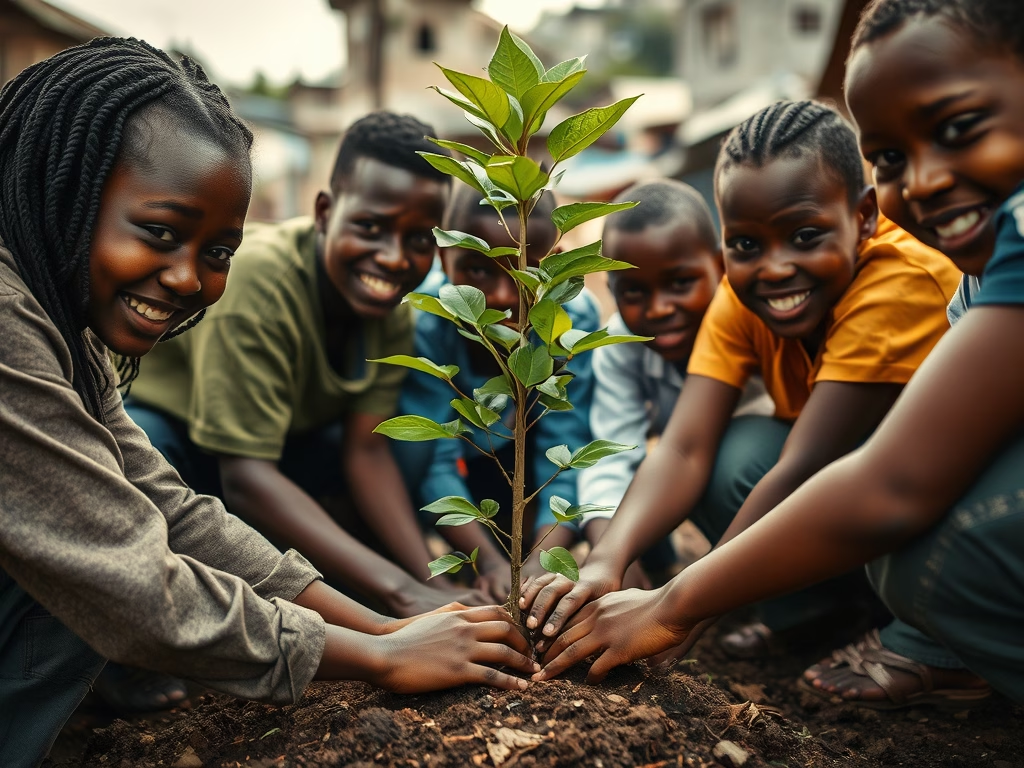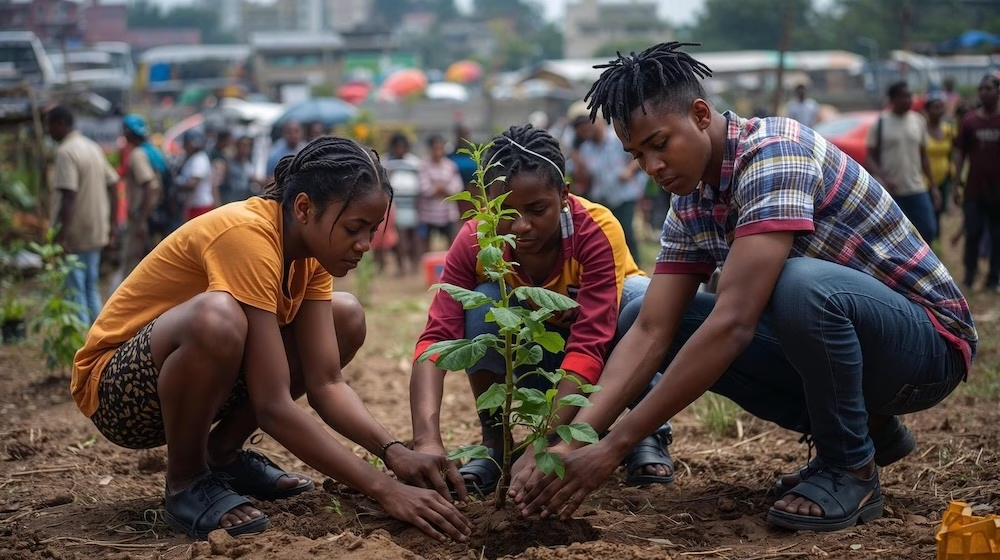
Korogocho: The Face of Kenya’s Urban Environmental Reality
Introduction
Korogocho, one of Nairobi’s most densely populated informal settlements, stands as a vivid symbol of Kenya’s urban environmental challenges. This Mazingira Day should shed light on this slum. Then everyone in charge would know what to do. Lying next to the vast Dandora dumpsite, it faces daily struggles with pollution, unsafe water, poor sanitation, and toxic air — realities that contrast sharply with Kenya’s environmental ambitions celebrated on Mazingira Day.
Yet, amid hardship, Korogocho’s residents show resilience through community clean-ups, recycling initiatives, and local adaptation to climate stress. The settlement highlights the urgent need for structural reforms in waste management, sanitation, and urban planning, turning Mazingira Day’s ideals into lasting change.

While Kenyan government officials are calling on Kenyans to go back to primary schools and plant trees there, they have long since been further ahead in Korogocho. One of the most impressive grassroots initiatives is the WAKULIMA YOUTH GROUP in the heart of Ngomongo in the Korogocho slum. A few years ago, young people set out not only to clean up their neighborhood, but also to start planting green plants. Now they also grow vegetables. This is what is known as “urban gardening” in rich countries – and is often more chic than substantial.
Regardless of the many speeches given on this day – not only in Kenya – these young people bear witness to the need to change their slum. And they are doing this by simply taking action instead of writing dozens of empty pages and making solemn promises. They are doing something very concrete for the environment that helps not only themselves but the entire community.
Korogocho: The Face of Kenya’s Urban Environmental Reality
If Mazingira Day expresses Kenya’s environmental aspirations, Korogocho embodies its hardest environmental truths. The name Korogocho, meaning “crowded shoulder-to-shoulder” in Kikuyu, accurately captures the density of life here. Situated about 11 kilometers northeast of Nairobi’s city center, Korogocho covers less than one square kilometer but is home to tens of thousands of residents. For decades, it has existed at the intersection of poverty, pollution and perseverance, making it an unavoidable lens through which to understand Kenya’s urban environmental crisis and the significance of Mazingira Day’s call to action.
A short drive separates the polished avenues of downtown Nairobi from the unpaved, labyrinthine alleys of Korogocho. Along the road approaching the settlement, smoke often curls from open fires burning mixed garbage — plastic, fabric, food waste, electronic scraps — rising into the city’s dry air. The scent is acrid, a reminder that environmental degradation is not an abstract problem but a daily reality for millions of Kenyans.
The geography of neglect
Korogocho lies adjacent to the Dandora dumpsite, Nairobi’s main landfill. For decades, this dumpsite — described by UN Habitat as one of Africa’s largest — has been the final destination for much of the city’s uncollected waste. Trucks deposit heaps of garbage in layers that stretch for acres, forming hills of refuse visible from the surrounding neighborhoods. The dumpsite receives an estimated 2,000 tonnes of waste every day, much of it unsorted and untreated.
Residents of Korogocho live within a few hundred meters of this mountain of debris. Many rely on it for income, sorting through the waste for recyclable materials such as plastic bottles, metal fragments or glass pieces. It is an economy born of necessity, not choice. According to the National Environment Management Authority (NEMA), informal waste picking provides livelihoods for thousands of people in Nairobi, yet exposes them to hazardous fumes, infectious waste and unstable heaps that sometimes collapse after heavy rains.
On Mazingira Day, local NGOs organize clean-ups around these perimeters, collecting plastics and restoring drainage channels. However, without long-term waste-management reform, such gestures remain temporary relief in a system that continues to pour untreated waste into the same site.
Mazingira Day: Environmental health in the slum
Water is another precarious frontier. In Korogocho, clean water arrives mostly through informal vendors who fill jerrycans from community taps or boreholes. The Kenya National Bureau of Statistics reports that Nairobi’s informal settlements still lag far behind the city average in access to safe drinking water. Sewer systems barely reach these neighborhoods, and much of the settlement relies on pit latrines or open drains that empty into the Nairobi River. The NEMA State of Environment Report 2019–2021 found high concentrations of coliform bacteria and heavy metals in water samples downstream from Korogocho.
During the rainy season, flooding transforms narrow alleys into fast-moving brown channels that carry waste, sewage and plastic through homes. When the rain stops, the same channels dry into ditches of blackened sludge. The absence of adequate drainage makes each downpour a potential disaster, while the accumulation of stagnant water afterward fuels outbreaks of waterborne diseases.
In this sense, Korogocho’s environmental predicament is inseparable from Kenya’s wider urban governance challenge. Nairobi’s population of over four million generates more waste and wastewater than its municipal systems can handle. Without formal collection, communities create their own responses: makeshift dumping grounds, open burning, informal recycling. It is efficient in its own way but devastating in environmental terms.
Air and soil pollution: invisible threats
Air quality in Korogocho is shaped by two major factors — open waste burning and domestic fuel use. Most households cook with charcoal or kerosene, releasing fine particulate matter that lingers in the still evening air. At the dumpsite, the combustion of plastics produces dioxins and other toxins. Studies by the University of Nairobi’s Department of Environmental Sciences show that airborne particulate levels around Dandora often exceed the World Health Organization’s recommended limits several times over.
Soil samples taken near the dumpsite reveal traces of lead, cadmium and mercury. These pollutants enter food chains when residents cultivate small vegetable plots using the contaminated soil or when animals graze near the area. It is a cycle that silently transfers toxins from waste to water to body, illustrating how urban pollution undermines health and productivity.
Social resilience amid environmental strain
Despite these conditions, Korogocho is not defined only by despair. Environmental degradation coexists with community organization and informal innovation. Over the years, numerous self-help groups have emerged to manage waste, run small recycling enterprises and promote hygiene. Community clean-ups, often supported by NGOs like UN-Habitat or local churches, mobilize youth to clear drains and collect plastics for resale.
These efforts resonate with the spirit of Mazingira Day — local action for collective good. When volunteers pick up litter or plant small shade trees along narrow footpaths, they demonstrate that environmental consciousness can take root even in the most marginalized settings. Yet sustaining these efforts demands structural support. Without municipal waste collection, tree seedlings die in dry seasons, drains fill again, and the same fires return.
Environmental economists argue that integrating informal recyclers into formal waste-management systems would yield multiple benefits: reducing open burning, improving recycling rates and creating safer jobs. A 2023 report by the United Nations Environment Programme (UNEP) Africa Office suggested that Kenya’s transition to a circular economy could generate tens of thousands of new positions in sorting, reprocessing and composting — many suitable for residents of settlements like Korogocho.
The role of Mazingira Day in urban settlements
Each October, as Mazingira Day unfolds across Kenya, Korogocho participates with energy and determination. Community organizations host street clean-ups, distribute seedlings, and stage educational events in schools and churches. Government officials occasionally visit, planting ceremonial trees and promising drainage upgrades. The symbolism is powerful: environmental inclusion, at least for a day.
But the deeper question persists — what happens on October 11? The effectiveness of Mazingira Day depends on continuity. Experts from the Kenya Institute for Public Policy Research and Analysis (KIPPRA) note that periodic campaigns must evolve into year-round programs, with county budgets allocated for waste management and drainage maintenance. Without that transition, the day risks becoming a ritual of aspiration rather than transformation.
In the long term, sustainable improvement in Korogocho and similar neighborhoods will require multi-level action: re-engineering of the city’s waste systems, upgrading sanitation infrastructure, strengthening public health monitoring and enforcing pollution control. These are not tasks for a single day, but Mazingira Day can serve as an annual reminder and catalyst.
Nairobi’s wider urban ecology
Nairobi’s environmental map reflects its social divisions. Affluent suburbs enjoy manicured green spaces, while informal settlements shoulder the burden of pollution. The Nairobi River, once a clear artery flowing from the highlands through the capital, now carries untreated waste for much of its course. The Nairobi River Regeneration Programme launched by the Ministry of Environment aims to rehabilitate the waterway through coordinated waste removal and relocation of illegal dumping sites. Progress has been uneven, hindered by funding constraints and the sheer scale of urban waste inflow.
Urban planners argue that environmental restoration in the capital must include social justice. Cleaning the river without addressing upstream sewage, household waste, and informal settlement infrastructure merely displaces the problem. A comprehensive approach would integrate settlement upgrading, secure land tenure and access to services — enabling residents to protect their environment rather than live atop its hazards.
Climate vulnerability and adaptation at the community level
Climate change amplifies Korogocho’s vulnerability. Extreme rainfall events overwhelm drainage channels, while heatwaves intensify the health burden for people living in tin-roofed structures. The State of the Climate Kenya 2024 report lists urban heat stress as an emerging risk, with surface temperatures in informal settlements up to five degrees Celsius higher than in greener neighborhoods.
Community adaptation strategies, though modest, reveal practical resilience. Residents plant fast-growing trees for shade, use repurposed containers for rooftop gardens, and build raised walkways to navigate flood seasons. These initiatives, aligned with national adaptation plans, show that environmental awareness can evolve organically from necessity.
Measuring the bigger picture
For policymakers, Korogocho is both a warning and a lesson. It illustrates the cost of under-investment in basic services and the potential of community initiative when given support. On Mazingira Day, policymakers frequently cite Korogocho as evidence of why environmental management cannot be left to individual responsibility alone. It requires structural change, integrated planning and accountability.
The broader numbers underline this reality. The Kenya National Bureau of Statistics Compendium of Environment Statistics 2023 estimates that only about 45 percent of solid waste in Kenyan urban areas is collected and properly disposed of. The rest accumulates in open spaces, riverbanks or illegal dumps. Air-quality monitoring data from NEMA reveal that particulate concentrations in Nairobi occasionally surpass the recommended daily average by more than four times during dry months. Such statistics convert visible pollution into measurable risk, reinforcing why national initiatives like the 15 Billion Tree Programme and county waste reforms are essential.
The connection between environment and health
Environmental degradation in Korogocho has direct human consequences. Studies by health institutions including Amref Health Africa have linked poor sanitation and contaminated air to higher rates of respiratory and diarrheal diseases in informal settlements. Children are the most affected, facing chronic exposure to pollutants from an early age. Addressing environmental challenges is therefore simultaneously a public-health intervention.
The Mazingira Day campaigns increasingly emphasize this intersection. School programs on October 10 now integrate hygiene education, teaching children that a clean environment is both a right and a defense against disease. Such integration aligns with Article 42 of Kenya’s Constitution, which guarantees every citizen a clean and healthy environment, enforceable through the courts.
Toward a sustainable urban future
Looking forward, environmental experts see Nairobi at a crossroads. Population growth continues, placing further strain on housing, sanitation and waste systems. Yet opportunities for innovation are expanding. The rise of youth-led environmental enterprises — from recycling startups to green-building initiatives — suggests a shift in attitudes. Kenya’s broader push for renewable energy and climate financing could complement local urban-ecology reforms, linking national sustainability with neighborhood resilience.
Korogocho’s story underscores that sustainability cannot be imported; it must be built from within. Each sapling planted on Mazingira Day, each drain unblocked, each community meeting about waste reduction contributes to a cumulative change. When these acts become institutionalized — backed by data, funding and coordination — they transcend symbolism.
Mazingira Day as a mirror of progress
As dusk falls on October 10, the smell of smoke still lingers over Korogocho. The day’s clean-up piles line the edges of footpaths, awaiting pickup. Children chase each other around newly planted trees, and local volunteers pack up their tools. The next morning, life resumes its usual rhythm. Yet the seedlings stand as small promises — green signals of continuity between aspiration and action.
In this way, Mazingira Day mirrors the broader Kenyan environmental journey: a work in progress marked by ambition, partial success and persistent challenge. Its annual recurrence ensures that the conversation never fully fades. Each year adds another layer of awareness, another set of commitments, another chance to connect national policy with the lived realities of communities like Korogocho.
The road to environmental justice in Kenya is long, but the spirit of Mazingira Day keeps it visible. From the forests of the Mau to the crowded lanes of Nairobi’s informal settlements, the message remains consistent — the environment is not an external entity to be fixed but a shared space to be sustained.







Du muss angemeldet sein, um einen Kommentar zu veröffentlichen.